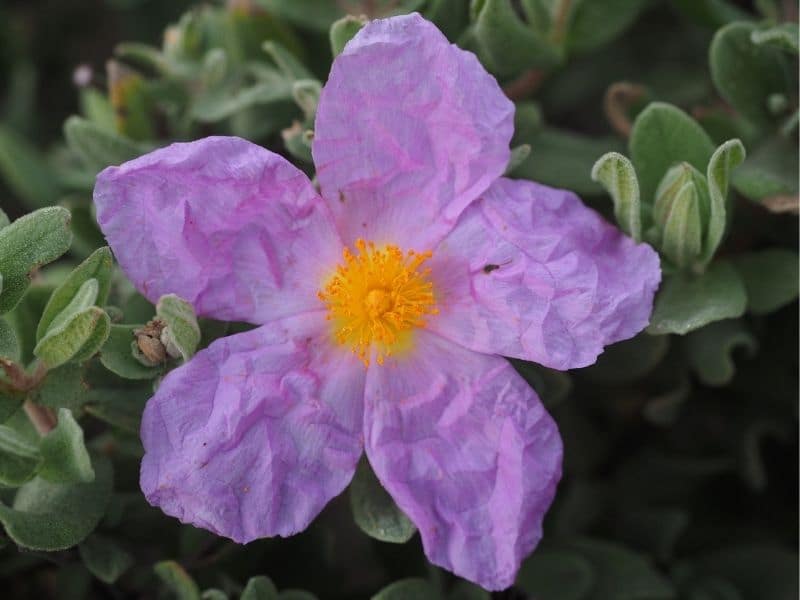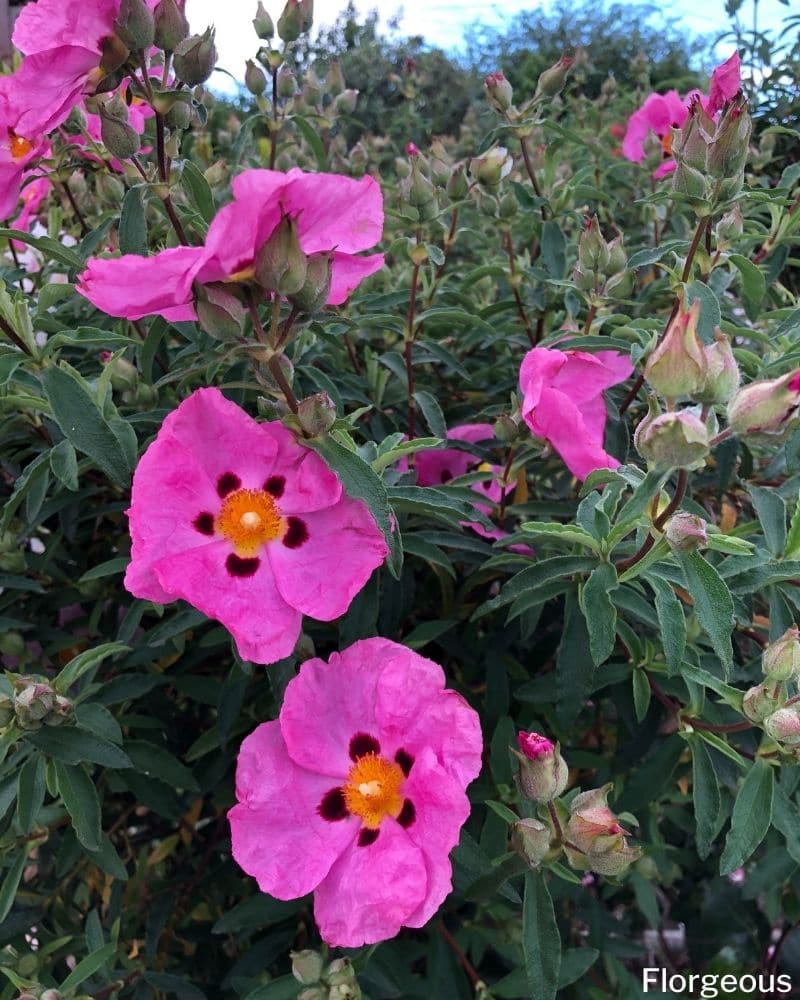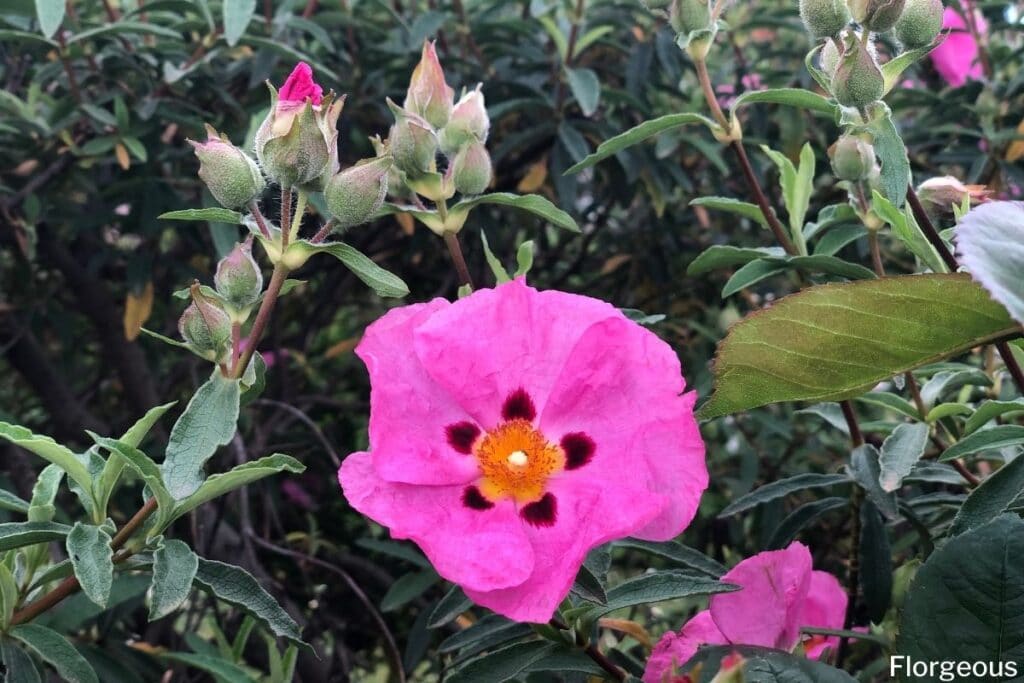The rockrose formally known as cistus is a unique name for a unique-looking flower. The flowers on the rockrose have a crinkled look that resembles the texture of rock—but much softer to the touch.
These low-maintenance flowers will grow effortlessly under the right conditions and will make a beautiful addition to any garden.
Another unique characteristic of rockrose flowers is the length of time that they stay in bloom. Flowers on the rockrose only bloom for a couple of hours each—so you need to be quick!
After their blooming debut is through, the flowers fall off to make room for new, incoming flowers, and the cycle repeats itself.
What are Rockroses?

Rockroses (Cistus spp.) are part of a group of flowering perennial evergreen shrubs, although different varieties have different growing patterns.
Part of the Cistaceae family and the Cistus genus, the rockrose group contains about 20 different species of perennial shrubs. It’s a very common garden flower, to say the least.
Some varieties grow as a traditional shrub and can be trimmed as hedges while others spread out and can be grown as a ground cover. Both varieties grow beautiful and vibrant flowers, and there are multiple different color options to choose from.
Flower colors for the rockrose can be found in purples, pinks, whites, and yellows.
Although the flowers themselves are not particularly fragrant, the foliage is said to have a sweet scent similar to an amber fragrance. The flowers make up for their lack of fragrance in the beauty and vibrancy they have when they bloom.
Rockrose is considered a hardy perennial in USDA growing zones six through ten, encompassing much of North America. In these zones, rockrose plants will come back year after year if cared for properly.
Thankfully, the rockrose plants are generally pretty hands-off plants to grow, and they won’t require much of your attention. Rockroses are also tolerant of poor soil quality, droughts, and high temperatures.
Types of Rockrose Flowers
There are several different varieties of rockrose flowers. Some varieties will grow as ground cover while others will spread themselves out. Different varieties will also bring certain colors, and many different color options are available!
Knowing where you want to plant your rockrose shrubs and what purpose you want them to serve will help you determine which variety is the best fit for your garden or landscaping.
Cistus Purpureus

The cistus purpureus (Orchid rockrose) is one of the most vibrant varieties of rockrose. The flowers are a purplish-pink color with maroon blotches near the center of each petal and the classic yellow center.
Although these flowers only bloom for a few hours each, new flowers will take their bloom and will continue to come up between spring and early summer.
This variety of rockrose forms as a shrub reaching four to six feet tall. The size of these shrubs makes them ideal for privacy hedging or landscaping on the side of a building.
Cistus Creticus

This variety of rockrose boasts bright-pink flowers with a yellowish-orange center called the stamen. Although not as vibrant as the cistus purpureus, the colors are bright and eye-catching.
This variety will bloom from spring to early summer and will continuously replace old blooms with new flowers.
The cistus creticus grows as a smaller shrub, reaching between two to four feet tall at maturity. This size shrub is ideal for creating borders or small hedges.
Cistus Albidus

The cistus albidus is another pink variety, but it has a deeper pink than other varieties previously mentioned. This variety will have solid pink petals with a smaller yellow stamen in the middle.
These pink flowers also prefer slightly warmer temperatures and do best in growing zones nine through ten, although they have been known to grow in cooler climates—such as zone six—as well.
These evergreen shrubs will grow between one and three feet tall and are often grown and trained as a ground cover.
Cistus Pulverulentus
Planting the cistus pulverulentus will add beautiful magenta-colored flowers to your garden or landscaping. This intense and vibrant color is magnified by the orange stamen that forms in the center.
This variety will continue to have blooming flowers until the end of summer—a little bit longer than the other varieties previously mentioned.
The cistus pulverulentus is another variety that is commonly used as a ground cover. With a maximum height of three feet, it can be trained to grow horizontally more than it does vertically.
Cistus Ladanifer
The cistus ladanifer rockrose variety truly stands out beyond the rest. The flowers that form are a bright white color with a dark maroon blotched center and a bright yellow stamen in the center.
These flowers are also larger than most other varieties, catching the eye of anyone in the nearby vicinity. Each flower only lasts a few hours, and blooms continue to grow for approximately a month in the summer.
This variety of rockrose grows anywhere from three to five feet tall and is often grown as a large shrub. They are often used to create small privacy borders or in landscaping around the house.
Cistus Corbariensis
This variety of rockrose also forms bright white flowers but without the maroon colored blotches. The center of these flowers has a bright yellow stamen that makes the white pop against its background.
The flowers on these plants are not as large as the ladanifer variety but instead closer to an average-sized rockrose flower.
The cistus corbariensis variety grows between two and five feet tall. They can be trained to grow as a ground cover if started early on, but they also make great shrubs when allowed to grow a little bit taller.

How to Care for Rockroses
Although rockroses are a fairly self-sufficient plant, some ideal situations will help them to thrive and provide the greatest number of blooms possible.
Under the right circumstances, your rockroses will be coming back year after year with beautiful blooms that are well worth the wait—just don’t miss them!
Soil
Choose a location with deep soil so that the rockrose may develop deep, spreading roots.
When it comes to the soil for rockrose flowers, drainage is the most important aspect. As long as they are planted in a well-draining area, the quality of the soil is not high on the importance list for rockroses.
Many have been known to grow and even thrive in poor quality soil, assuming other basic needs are still being met.
The rockrose plants can even grow in rocky and sandy environments as long as they can spread their roots—they truly aren’t picky!
Water
Rockroses are considered drought-resistant plants, and they generally do not require any watering as long as they are receiving water from rainfall.
However, if you are having an unusually dry season, it would not hurt to water your rockroses every few weeks to ensure the plant has enough energy to create its beautiful flowers.
When first starting your rockrose plants, it is a good idea to water them while they become established. Although not always necessary, extra water will help the plant better adapt to its new environment and will take off some stress while the plant is establishing itself.
Sun Exposure
One of the most crucial aspects to consider when growing your rockroses is the sunlight that they require to grow. Rockrose flowers require a full-sun environment to ensure they have the proper energy needed to create flowers and bloom.
If needed, most rockrose varieties can be grown in a partially-shaded environment assuming they are still getting a significant amount of sunlight. Rockroses are not able to survive in environments that have too much shade.
Pruning
For the most part, rockroses will not tolerate heavy amounts of pruning. If you do need to prune your rockroses, it is generally a good idea to do so right after the flowers have stopped blooming for the season, and it is best to do so only lightly.
Prune immediately after the flowers fade to protect the buds that will develop the flowers for the next year. Avoid severe trimming since weak branches may stop bearing flowers in the future.
Fertilizer
Fertilizing is almost never necessary with rockrose flowers, and it can actually do more harm than good by overwhelming the plants with nutrients. The only exception to this is right after planting your rockroses for the first time.
When your rockroses are busy putting all of their energy into establishing themselves in a new environment, a slow-release fertilizer can help give them the boost they need to establish and mature.
There are no specific fertilizers designed for rockroses, and a general fertilizer should work just fine for initial establishment.
Humidity
Rockroses prefer dry environments and do not do well in areas with high humidity. Although some humidity can be tolerated, they may not thrive as well as they would in a dry environment.
If you live in a climate with moderate humidity, just be sure to avoid overwatering your rockroses, as this can overwhelm the plant and stunt growth.
It is also important for the winter months to be dry to help encourage the plants to come back the following year. Some winter protection may be required in cooler climates to keep your rockroses as perennials.
Growing Rockroses in Containers
If you live in a cooler climate or just don’t have the garden space for flowers, you can always grow your evergreen shrub in a container. Rockroses grown in a container can thrive just as well as those grown in a garden or as landscaping, assuming the right conditions are met.
Something to consider when planting your rockroses in a container is that they prefer their soil lightly moist, and not saturated with water. The soil in a small container is more likely to need watering more often, keeping the soil at a higher moisture level.
When planting in a larger container, more soil will be available for the water to spread out and your flowers won’t need to be watered as frequently.
If you are growing your rockroses in a container that is to be brought inside during the winter, it is a good idea to transport that container inside shortly after the final flowers have bloomed.
Rockrose plants that are exposed to cold temperatures over a long time or a frost may not come back for another year of growth, and bringing them inside can prevent that.
If you want to start your rockroses in a container, they are easily transplanted from a container to a garden. However, once planted in the ground, rockrose plants will most likely not be able to adapt to living in a container.
Common Diseases for Rockroses
Although rockroses are a fairly resilient plant, there are a few diseases that can bring it down and are, therefore, worth monitoring. Early prevention is often key to getting these diseases under control and reclaiming your beautiful plant and flowers.
Powdery Mildew
Powdery mildew is one of the most common diseases to look out for on your rockrose flowers. This fungal disease causes damage to the leaves of the plant and is identifiable by the white powder-like substance that forms on the leaves.
Once powdery mildew is on any of your flowers, quick action is required because the disease can spread quickly.
To get rid of powdery mildew, you can either remove infected areas—as long as the whole plant has not been affected—or you can spray it with a mixture of water and dish soap to thwart this disease.
Sooty Mold
Sooty mold is another fairly common disease that may affect your rock roses. This disease is recognizable by the fuzzy black growth that occurs on the foliage.
Sooty mold is brought by pests that leave behind sticky substances that encourage the growth of this mold. The mold does most of its damage by blocking out vital sunlight that the plant needs to grow and thrive.
In most cases, sooty mold can simply be wiped away with a small washcloth or wet paper towel. If the disease has completely taken over the plant or has affected a large number of plants, spraying an insecticidal soap on infected areas may also do the trick.
Verticillium Wilt
Verticillium wilt is a fungal disease that creates discoloration and yellowing of the affected leaves. The leaves will, over time, start to wilt and fall off the plant, making the entire plant more unhealthy than it would have been otherwise.
If this disease continues, it can spread from the leaves to the branches and has the potential to kill the plant after some time.
Unfortunately, there is not much that can be done to treat verticillium wilt once it has infected a portion of your plant. The best course of action is to remove and destroy any infected areas as quickly as possible.
Keeping your plants in an overall healthy state will help them fight this fungal disease on their own.
FAQs
Is rock rose fragrant?
While rockrose (Cistus) flowers are generally unscented, the leaves release a sweet, resinous aroma, similar to Mediterranean herbs like lavender or rosemary.
What is the meaning of Rockrose?
The rockrose, or Cistus, is associated with symbolism related to love and admiration. It represents the concept of universal love and the appreciation of beauty, making it a meaningful choice for gardens and floral arrangements.
Is rockrose native to Texas?
Yes, some species of Rockrose in the genus Cistus are native to Texas. Cistus ladanifer, commonly known as gum rockrose.







